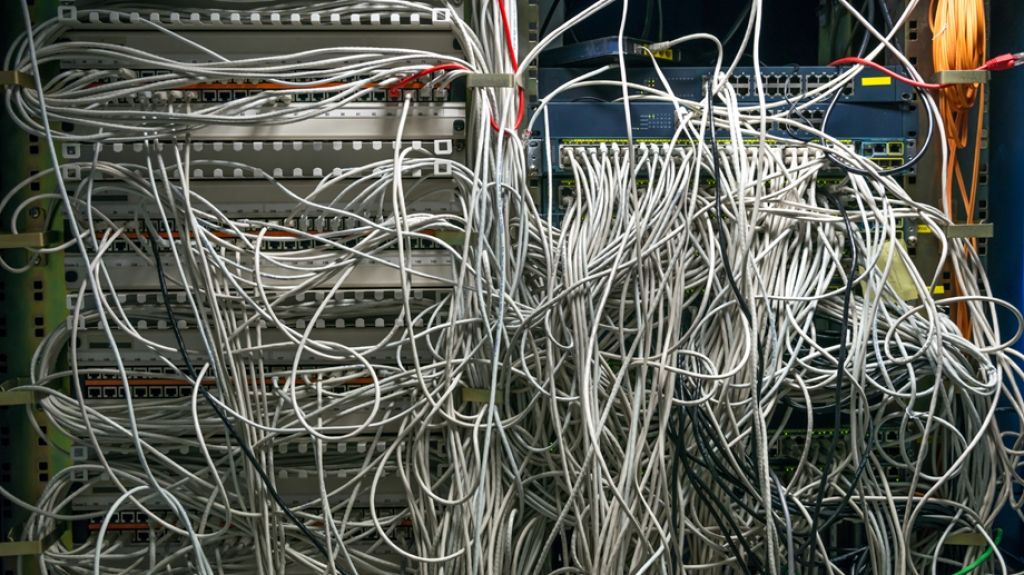AV Cable Management: Combining Functionality and Aesthetics
Your AV setup might dazzle on the outside, but what’s behind the rack—order or chaos? Check out our article to learn how to overcome tangled cables and keep your system running smoothly.
In the world of AV integration, the focus often centers on the technical performance of systems: video synchronization, precision of control systems, or the clarity of audio outputs. However, AV cable management—an aspect that may seem secondary at first glance—can consume more time, energy, and attention than anticipated. Yet, it’s a critical component that directly influences both the functionality and the professional appearance of an installation.
The meticulous organization of cables is especially important when dealing with 24/7 systems, which are designed to run continuously for up to a decade without interruptions. Poor AV cable management can compromise the reliability and serviceability of such critical components, leading to significant operational issues for the end user.
Balancing Practicality with AV Cable Management
The goal of any AV integrator should be to create a system that is not only technically sound but also visually clean and easy to maintain. This includes labeling every cable clearly, securing wires to prevent tangling, and ensuring accessibility for future adjustments. Clients may not initially pay attention to what’s behind the rack or hidden in the ceiling, but over time, especially during maintenance or upgrades, they will notice whether the system was designed with care and foresight.
Imagine a scenario where technicians revisit an installation a year later to troubleshoot potential problems and complications. If the cables are unlabeled, poorly routed, or tangled, the time required to diagnose and resolve the issue can increase significantly. This not only costs the client more in support hours but can also damage the integrator’s reputation. On the other hand, a clean and methodical setup communicates professionalism and instills confidence in the integrator’s expertise.
Technical Solutions for Effective AV Cable Management
To meet both functional and aesthetic goals, integrators can employ several practical strategies and tools. Below is a list of proven techniques and solutions to simplify AV cable management while ensuring long-term reliability:
1. Cable Trays and Wire Ducts
Using cable trays or wire ducts ensures that cables are grouped together in a structured way. Excessive cables can obstruct airflow, leading to higher temperatures that may cause overheating issues. These tools not only keep the cables secure but also make them accessible for future modifications.
2. Velcro Straps and Cable Ties
While zip ties are commonly used, opting for reusable Velcro straps is a better long-term solution. These allow cables to be adjusted or added without having to cut and replace ties. Velcro straps also reduce the risk of over-tightening, which can damage sensitive cables.
3. Cable Labeling Systems
A clear labeling system is critical. Use pre-printed labels or thermal label printers to tag each cable with its function and destination. Properly marked cables help technicians immediately identify each connection.
4. Separation of Signal and Power Cables
To avoid electromagnetic interference (EMI), it’s essential to route power and signal cables separately. Signal cables (e.g., HDMI, SDI, Ethernet) should be bundled together and kept at a safe distance from power cables to ensure optimal performance.
5. Color-Coding
Use different-colored cables for different purposes. For example, blue for Ethernet, red for power, and yellow for video signals. This helps to visually separate functions and simplifies troubleshooting.
6, Patch Panels and Modular Connectors
Patch panels allow for clean terminations and make it easier to manage cables entering and exiting the rack. Modular connectors (like keystone jacks) help create a professional, standardized interface for plugging and unplugging cables.
7. Cable Lacer Bars
Lacer bars provide strain relief by supporting the weight of cables. They are especially useful in AV racks, where heavy bundles of cables can put undue stress on connections._resize.jpg)
8. Pre-Termination of Cables
For larger projects, pre-terminating cables can save significant time on-site. These pre-labeled, pre-measured cables reduce installation errors and ensure consistency
9. Documentation
Maintain detailed diagrams and notes about the cable layout and connections. A wiring map that indicates each cable's route and purpose will save hours during future maintenance or upgrades.
Futureproofing Through AV Cable Management
AV cable management isn’t just about making things look good today, it’s about ensuring the system remains functional and adaptable for years to come. AV installations often require future upgrades, such as adding new displays or expanding existing systems. A well-organized cable layout makes these transitions smoother, reducing downtime and minimizing the risk of damaging existing components during modifications.
For mission-critical components, where reliability and uptime are paramount, proper AV cable management ensures that the system remains robust and supportable over its entire lifespan. By investing in modular designs, detailed labeling, and separation of power and signal cables, integrators can help ensure the system maintains uninterrupted performance for years, even when updates or maintenance are required.
 |
 |
| DVP991 Multiviewer | DMX302x Matrix Switcher |
Conclusion
Effective AV cable management is far more than a matter of aesthetics; it’s a foundational element of any successful AV installation. From simplifying maintenance and troubleshooting to ensuring scalability and leaving a positive impression on clients, the way cables are managed can significantly influence the long-term success of a project. By combining technical solutions, integrators can create systems that not only perform well but also stand the test of time.